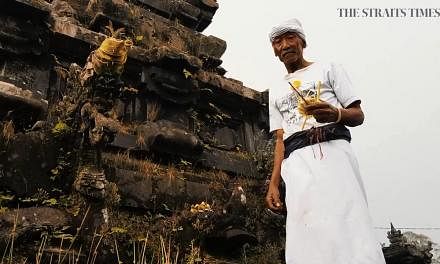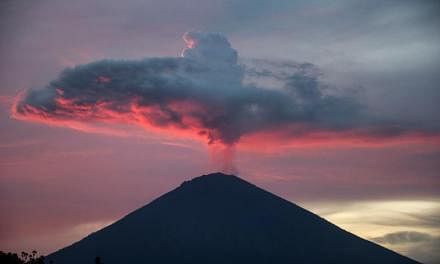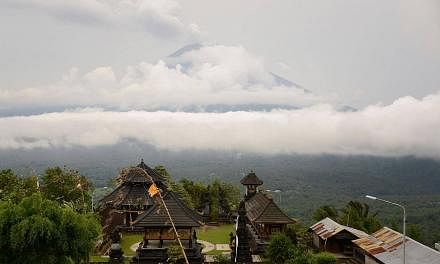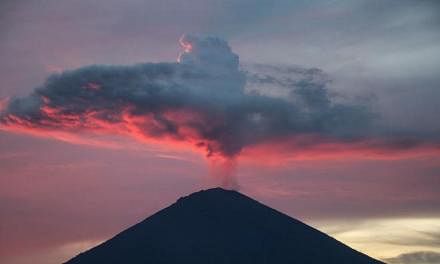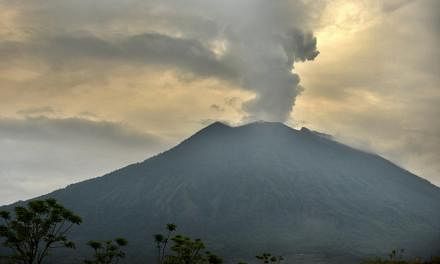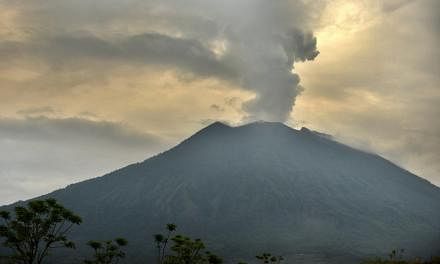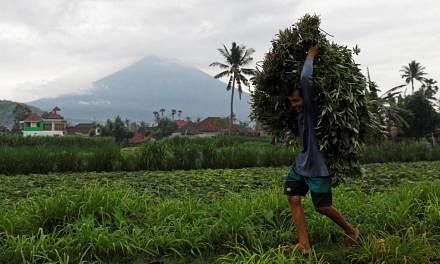JAKARTA (REUTERS) - Indonesia on Tuesday (Nov 28) extended the closure of the international airport in Bali by another 24 hours because of ash from the eruption of the island's Mount Agung volcano.
A report from local aviation navigation authorities showed that "aircraft flight channels are covered with volcanic ash".
The I Gusti Ngurah Rai International Airport was originally scheduled to reopen on 7am local time on Tuesday, but the authorities announced on Tuesday morning the airport will remain closed until 7am on Wednesday.
On Tuesday, 443 flights had been cancelled affecting up to 59,539 people, Ari Ahsan, spokesman for Ngurah Rai airport, told The Straits Times. That figure is based on the seat capacity of the cancelled flights.
Sseasoned travellers to Bali told The Straits Times in an earlier report that if the airport in Denpasar is shut down, travellers can still easily make their way over land and sea to Java where there are many airports to fly out from. Ten alternative airports have been prepared for airlines to divert inbound flights, including in neighbouring provinces.
"You can still go by car to Gilimanuk port where you can cross the Bali Strait by ferry to Banyuwangi in East Java," said Mr Herman Winarto, a diving instructor in Bali.
"From there you can travel by car, bus or train to other destinations in Java, such as Surabaya, Yogyakarta, Bandung, and then catch a flight out of Indonesia from Jakarta."
A separate notice showed Lombok airport had been reopened, after an earlier closure overnight due to the eruption.
On Monday, the authorities ordered 100,000 residents living near the volcano to evacuate immediately, warning that the first major, full-blown eruption in 54 years could be "imminent".
An eight to 10 km exclusion zone has been imposed around the summit.
Agung's last eruption in 1963 killed more than 1,000 people and razed several villages by hurling out pyroclastic material, hot ash, lava and lahar.
The spokesman for Indonesia's National Disaster Management Agency, Dr Sutopo Purwo Nugroho, said on Tuesday that Mount Agung's eruptions were continuing, ejecting volcanic material 2.5km to 3km high above the crater. The eruptions are now spewing out lava, indicating a new and more dangerous phase for the volcano.
"PVMBG (Indonesia's Volcanology and Geological Hazard Mitigation Center) has been reporting constantly increasing volcanic activity. Chances of greater eruptions are increasing. But we cannot predict the intensity," Dr Sutopo said in a statement.
On Tuesday, life continued largely as normal in villages surrounding Agung, with residents setting up traditional markets and offering prayers as the volcano continued to spew tall columns of ash and smoke from its crater.
Many residents evacuated in September when the alert was last raised to the highest level have returned to their homes and farms due to worries over their livelihood and livestock. The PVMBG, which is using drones, satellite imagery and other equipment, said predictions were difficult in the absence of instrumental recordings from the last eruption 54 years ago.
It warned that if a similar eruption occurred, it could send rocks bigger than fist-size up to 8km from the summit and volcanic gas a distance of 10km within three minutes.
Recordings now show the north-east area of Agung's peak has swollen in recent weeks "indicating there is fairly strong pressure toward the surface", PVMBG said.




